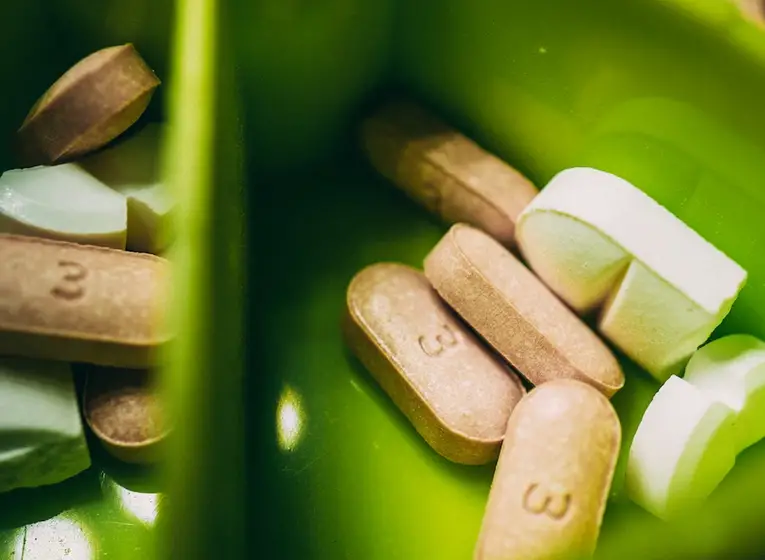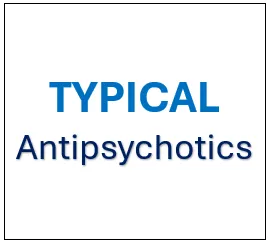Typical Antipsychotics – often known as First-generation antipsychotics – are a class of Antipsychotics.
Typical antipsychotics can be used to treat a plethora of mental health conditions – including Schizophrenia, Schizoaffective Disorder and other psychotic disorders.
The class of Typical antipsychotics have largely been replaced by the newer and safer Atypical antipsychotics. However, typical antipsychotics continue to be in clinical use.

Information on Typical Antipsychotics
Typical Antipsychotics provide a range of benefits. While it can take several weeks for an antipsychotic to help symptoms like delusions, hallucinations or disturbed thoughts, other symptoms like anxiety, agitation and mania should improve very quickly.
After around 6 weeks of taking typical antipsychotic medication, the full benefits should be evident.
It is crucial that a patient takes their antipsychotic how and when a Doctor has advised. This involves taking the correct dose at the right time, and taking the medication on a consistent basis.
The lowest dose thought possible to improve a patient’s mental health will initially be prescribed, although this may raise over time. In many cases, a patient will need to take antipsychotics for life.
In some disorders, recovery is possible. Even in these instances, it is recommended that antipsychotics are continued to be taken for a few months, in order to lessen the chance of a relapse.
What conditions are Typical Antipsychotics used for?
Typical antipsychotics can be used to help treat a vast array of conditions, such as, but not limited to:
- Psychotic Depression
- Delusional Disorder
- Brief Psychotic Disorder
- Shared Psychotic Disorder
- Bipolar I Disorder
- Schizophrenia
- Schizoaffective Disorder
- Some Personality Disorders
What are the different types of Typical Antipsychotics?
There are currently 15 typical antipsychotics that are licensed for use in the United Kingdom. Many of these medicines are no longer prescribed, or are purely offered in a hospital setting (e.g., Loxapine). These medicines were mostly developed in the 1950s.
- Benperidol (Anquil)
- Chlorpromazine (Largactil)
- Droperidol (Inapsine)
- Flupentixol (Depixol)
- Haloperidol (Haldol)
- Levomepromazine (Nozinan)
- Loxapine (Adasuve)
- Pericyazine (Neulactil)
- Perphenazine (Fentazin)
- Pimozide (Orap)
- Prochlorperazine (Stemetil)
- Promazine (Sparine)
- Sulpiride (Sulpor)
- Trifluoperazine (Stelazine)
- Zuclopenthixol (Clopixol)
How do Typical Antipsychotics work?
It is believed that symptoms of any psychotic disorder are caused by an excess amount of a chemical in the brain called dopamine. Dopamine is a neurotransmitter – something in the brain that is responsible for messages being passed around the brain.
Therefore, antipsychotics work mainly by blocking the D2 receptor – a subtype of the dopamine receptor. In theory, this limits the amount of dopamine that the brain produces.
Unlike atypical antipsychotics, typical antipsychotics do not act on serotonin – a neurotransmitter in the brain linked to mood and emotion.
Side Effects of Typical Antipsychotics
Side effects are common with typical antipsychotics. While each typical antipsychotic will feature different side effects, there are some consistent adverse effects.
Typical antipsychotics typically feature more intense side effects than antipsychotics in the atypical class. With any antipsychotic, a Patient Information Leaflet will be included in the box. This leaflet provides an exhaustive list of side effects.
Side effects from typical antipsychotics will often cause discomfort. Some side effects should only last a few days as the body gets used to the medication. Unfortunately, some side effects may persist throughout treatment.
Common side effects of typical antipsychotics include blurred vision, constipation, dizziness, dry mouth, nausea, drowsiness, irregular heartbeat, tardive dyskinesia, shaking, akathisia, sedation, agitation, tiredness, low sex drive and sexual dysfunction.
Serious side effects include suicidal thoughts, seizures, and a return of psychotic symptoms – known as Tardive psychosis. Neuroleptic Malignant Syndrome – a serious movement disorder characterised by high temperature, tremors, fever, difficulty in speaking and swallowing and changes in consciousness – is a serious condition that can prove fatal. It is a serious side effect.
If any of the side effects in this area appear, it is important to contact a Doctor or emergency department immediately.
Cautions of Typical Antipsychotics
It is important to thoroughly read the Patient Information Leaflet that comes with your medication. The leaflet will include specific cautions that should be taken into consideration when taking an antipsychotic.
General considerations when taking antipsychotics include:
- It is important to tell a Doctor or mental health professional about any other medication, substance or herbal remedy that is being taken, or has recently been taken, prior to taking an antipsychotic. Antipsychotics interact with several other medications – therefore making this very important.
- Avoiding alcohol in the first few days of treatment, to allow the body to get used to the medication. After the body has adjusted to the medication, it is still advisable to not consume alcohol, as it can worsen side effects.
- Any antipsychotic can react unpredictably with illegal drugs; therefore it is advisable to not use recreational drugs when undergoing antipsychotic therapy.
- People taking antipsychotics can often have suicidal thoughts. Suicidal thoughts may be likely to occur at the start of antipsychotic treatment.
- It is common for a patient to need to undergo a physical exam, blood test and possibly a heart test, prior to engaging in antipsychotic therapy. This will help a medical professional ascertain the overall health of the person. Overall health will need to be monitored throughout treatment.
- Antipsychotics should not be suddenly stopped. If an individual wishes to withdraw from an antipsychotic, it is important to gradually withdraw – best achieved by gradually lowering the dose over a period of few weeks. Sudden withdrawal can cause withdrawal symptoms, and in some cases, the potentially fatal Neuroleptic Malignant Syndrome.
Summary
Typical antipsychotics have a proven track record of helping many people with their mental health. They have been in operation for several decades.
However, their use does typically come with a range of side effects. It is important to talk through your options with your doctor or mental health professional.
See Also
- Text
Disclaimer
This website should be used purely for informational purposes, and does not intend to, nor should it ever, be used as a replacement for professional medical advice.
We strive to keep all of our pages updated, and ensure that our website is full of factual and in-depth information. However, we encourage you to browse this website with care.
As a reminder, this website and all content within it cannot and should not replace the advice of a trained medical professional. You can read our full disclaimer at this link.
Helplines
If you are struggling with your mental health, help is available. With the right support and treatment, you can make a recovery. For information on helplines, or if you are in a state of crisis, please visit our crisis page by clicking on the relevant link for your geographical location (United Kingdom), (United States), (International). You can also see how to get mental health treatment and the process involved by clicking this link.



























